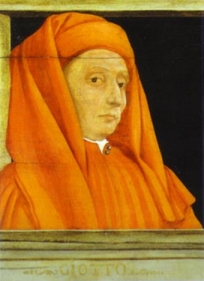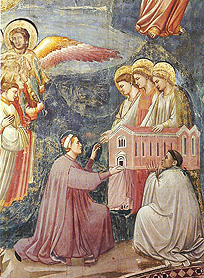Giotto was one of the most important and accomplished masters of 14th century Italian painting. His most widely recognized masterpiece is the set of 39 frescos with biblical scenes that adorn the Scrovegni Chapel in Padua. They are clearly the works of a creatively and artistically fully developed artist. Giotto was also the most innovating artist of his time. Going well beyond the then current static Byzantine style, he created dynamic, life-like personas. His understanding of optics and intuitive sense of perspective allowed him to create truly three-dimensional images. Giotto was far ahead of his time: he was the first Renaissance painter, a century before that epoch really started, and his contributions were only properly understood when his influence became apparent in the works of Renaissance geniuses such as Michelangelo and Leonardo da Vinci.
Giotto di Bondone (1267/1276 - 1337), the son of a tiller called Bondone, was one of the greatest Italian painters of the14th century. He is also called the father of Renaissance painting. This genius of the brush, whose work later became an inspiration to two of his true spiritual heirs, Masaccio and Michelangelo, was born at Vespignano near Florence, in the Mugello Valley either in 1267 or 1276 according to the famous biographer Giorgio Vasari and several other scholars. Not much is known about his private and artistic life but his surviving works tell us a great deal about his artistic development.
Giotto was a student of Cimabue, another great Italian master. Giorgio Vasari in his ”
The Lives of the Artists” relates that Cimabue, on his way from Florence to Vespignano,
encountered the ten years old boy Giotto and took him on as his pupil. In Vasari's own words:
”One day Cimabue was going about his business between Florence and Vespignano,
and he came upon Giotto who, while his sheep were grazing, was sketching one of them
in a lifelike way with a slightly pointed rock upon a smooth and polished stone without
having learned how to draw it from anyone other than Nature. This caused Cimabue
to stop in amazement, and he asked Giotto if he would like to come to work with him.
The young child replied that if his father would allow it, he would willingly do so.
Cimabue therefore asked Bondone, and he lovingly gave his consent and
allowed Cimabue to take Giotto to Florence.”
 Following Cimabue's artistic guidelines, which were heavily influenced by Medieval
Greek and Byzantine paintings, Giotto painted his Jesuses, Madonnas and Childs, Saints
and other religious beautifully preserved masterpieces. However, unlike his master,
Giotto brought to the rigidly, schematic Byzantine style the expressiveness, spirituality,
grace and liveliness of natural models. In Giotto's works human beings are
living individuals. In the great tradition of Christian drama they act out their roles
in sacrifice, crucifixion, redemption
and resurrection with devout passion.
Following Cimabue's artistic guidelines, which were heavily influenced by Medieval
Greek and Byzantine paintings, Giotto painted his Jesuses, Madonnas and Childs, Saints
and other religious beautifully preserved masterpieces. However, unlike his master,
Giotto brought to the rigidly, schematic Byzantine style the expressiveness, spirituality,
grace and liveliness of natural models. In Giotto's works human beings are
living individuals. In the great tradition of Christian drama they act out their roles
in sacrifice, crucifixion, redemption
and resurrection with devout passion.
One of his best-known masterpieces is the series of 39 frescos in the Scrovegni Chapel in Padua, which were commissioned by Enrico Scrovegni and painted in 1305-1306. Although all frescos have survived to this day, unfortunately they all sustained damage. Nonetheless, their complexity in terms of iconography and composition exemplifies the full maturity of Giotto's artistic development. His experiments and achievements in the areas of light and color, perspective and geometric division of space places his art, a hundred years ahead of its time, among such geniuses of the Renaissance as Masaccio (1401-1428) and Leonardo da Vinci (1452-1519).
The name of the chapel stems from the fact that it was built by Enrico Scrovegni, the son of a notorious usurer. On January 6, 1300, Scrovegni bought a large piece of l and on the site of an ancient Roman Amphitheatre, where he built his palace and chapel. In doing so he may have wished to purge the sins committed by his father.
The architecture of the chapel seems to have been designed around the needs of the painted decorations. Some scholars suggest even that Giotto himself was the architect. The walls of the chapel are divided following Gothic tradition into several panels and the size of their figures vary in accordance with the Byzantine hierarchy of Saints. The founder of the Chapel is shown in the scene of ”The Last Judgment”, one of the most popular iconographic themes of the Middle Ages. Kneeling in devotion Enrico Scrovegni is offering a model of the chapel to the Madonna. The Madonna expresses her pleasure by directing her gaze and hand toward him. For the first time in the history of art, a hundred years before Van Eyck, Giotto presented his commissioner on the same scale as the Madonna and the Saints. This did not become an artistic convention until 100 years later!
 The majority of the scenes on the frescos in the Scrovegni Chapel are narrative,
depicting biblical stories in an easy to read fashion. They emphasize the dramatic
moment of each situation, intensified by specific gestures and glances. The actors
of the scenes, unlike in Byzantine art, are very natural in their expression of reality
and humanity. Their dresses are painted with a great deal of realism. By cunningly
playing with light and shadow across his figures, he created the illusion that they
are fully three dimensional beings inhabiting real space. He skillfully applied intuitive
perspective to make his half-height figures
seem much larger than they really are.
The majority of the scenes on the frescos in the Scrovegni Chapel are narrative,
depicting biblical stories in an easy to read fashion. They emphasize the dramatic
moment of each situation, intensified by specific gestures and glances. The actors
of the scenes, unlike in Byzantine art, are very natural in their expression of reality
and humanity. Their dresses are painted with a great deal of realism. By cunningly
playing with light and shadow across his figures, he created the illusion that they
are fully three dimensional beings inhabiting real space. He skillfully applied intuitive
perspective to make his half-height figures
seem much larger than they really are.
The narration of the scenes in the Chapel follows a chronological sequence of events taken from the Old and New Testaments, starting with the ”Scenes from the lives of Saints Joachim and Anne” followed by ”Scenes from the life of the Virgin Mary” and ”Scenes from the life of Jesus” (which include events from his Childhood and Passion) and ending with ”The Last Judgment.”
Giotto's frescos in the Scrovegni Chapel and his other major frescos established many major new conceptual and stylistic elements and he remained influential well into the Renaissance, over a century later. This the most extraordinary and innovative artistic adventure of the Mildde Ages ended in 1337.
List of major works by Giotto di Bondone in chronological order:
| 1296 - 1304: | Cycle of frescos ”Legend of Saint Francis”, San Francesco, Upper Church, Assisi, Italy |
| 1305 - 1306: | Cycle of frescos ”Life of the Virgin and Christ&148;, Scrovegni Chapel, Padua, Italy |
| 1307 - 1308: | ”Cycle of frescos ”Scenes from the Life of Mary Magdalen”, San Francesco, Lower Church, Magdalen Chapel, Assisi, Italy |
| 1312: | ”Crucifix”, Santa Maria Novella, Florence, Italy |
| 1310-11: | ”Madonna Enthroned and Saints” (also called Ognissanti Madonna), Uffizzi Gallery, Florence, Italy ”Crucifix”, Malatestian Temple, Rimini, Italy |
| 1315 - 1320: | Cycle of frescos ”Scenes from Lives of Saint John the Baptist and Saint John Evangelist”, Santa Croce Church, Peruzzi Chapel, Florence, Italy |
| 1320: | Stefaneschi Triptych”, Pinacoteca Vaticana, Rome, Italy |
| 1320 - 1325: | Cycle of frescos ”Scenes from Life of Saint Francis”, Santa Croce Church, Bardi Chapel, Florence, Italy |
| 1333: | ”Baroncelli Polyptych”, Santa Croce Church, Baronchelli Chapel, Florence, Italy |
| 1334 - 1335: | Cycle of frescos ”Scenes of the Life Saint Mary Magdalen and Last Judgement ”, Bargello Palace, Mayor's Chapel, Florence, Italy |
| 1333 - 1337: |
|